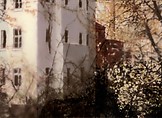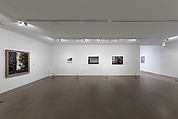Returned to lender The Met accepts temporary loans of art both for short-term exhibitions and for long-term display in its galleries.
Squatters' House
Gerhard Richter German
Not on view
Inconspicuous forms of architecture, the non-sites of daily experience, are prominent in Richter’s work. Examples include his anonymous cityscapes, paintings such as the formidably banal Administrative Building or the implausibly intimate Cathedral Corner (both displayed on this floor)—or his print Train Station (Hanover) (1967, not on view), which depicts one of the buildings from which German Jews were deported to ghettos and camps in the East under Nazi rule. This focus underscores the critical negativity of Richter’s aesthetic, which recognizes the shifting and unstable significance of places. Presenting the inconspicuous facade of a private dwelling veiled by delicate branches, Squatters’ House is all the more enigmatic, as the named illegality and intrusion of its unseen inhabitants seems to have confronted the artist with the question of what forms of belonging and public space—if any—could still be imagined.
This image cannot be enlarged, viewed at full screen, or downloaded.
This artwork is meant to be viewed from right to left. Scroll left to view more.



